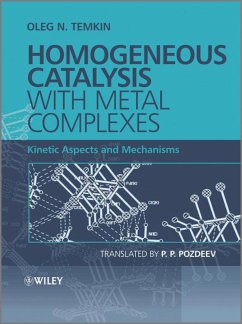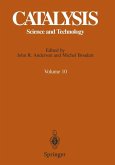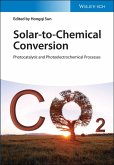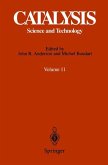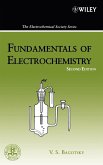Oleg TemkinKinetic Aspects and Mechanisms
Homogeneous Catalysis with Metal Complexes
Kinetic Aspects and Mechanisms
Übers. v. Pozdeev, P. P.
Oleg TemkinKinetic Aspects and Mechanisms
Homogeneous Catalysis with Metal Complexes
Kinetic Aspects and Mechanisms
Übers. v. Pozdeev, P. P.
- Gebundenes Buch
- Merkliste
- Auf die Merkliste
- Bewerten Bewerten
- Teilen
- Produkt teilen
- Produkterinnerung
- Produkterinnerung
This book presents a comprehensive summary of the results obtained over the last sixty years in the field of kinetics and mechanisms of organic and inorganic reactions catalyzed with metal complexes.
The specificity of the catalytic reaction kinetics in the presence of the different form of mono- and polynuclear metal complexes and nanoclusters is discussed. The multiroute mechanisms and the methods of their identification as well as approaches to the polyfunctional catalytic systems kinetics are presented. In addition, the mechanisms of active centers formation and the real, non-ideal…mehr
Andere Kunden interessierten sich auch für
![Basic Principles in Applied Catalysis Basic Principles in Applied Catalysis]() Manfred Baerns (ed.)Basic Principles in Applied Catalysis161,99 €
Manfred Baerns (ed.)Basic Principles in Applied Catalysis161,99 €![Catalysis Catalysis]() M. BoudartCatalysis81,99 €
M. BoudartCatalysis81,99 €![Solar-to-Chemical Conversion Solar-to-Chemical Conversion]() Solar-to-Chemical Conversion125,99 €
Solar-to-Chemical Conversion125,99 €![Catalysis Catalysis]() Michel BoudartCatalysis81,99 €
Michel BoudartCatalysis81,99 €![Fundamentals of Electrochemistry Fundamentals of Electrochemistry]() Vladimir S. Bagotsky (Hrsg.)Fundamentals of Electrochemistry221,99 €
Vladimir S. Bagotsky (Hrsg.)Fundamentals of Electrochemistry221,99 €![Katalyse Katalyse]() Katalyse109,95 €
Katalyse109,95 €![Introduction to Surface Chemistry and Catalysis Introduction to Surface Chemistry and Catalysis]() Gabor A. SomorjaiIntroduction to Surface Chemistry and Catalysis203,99 €
Gabor A. SomorjaiIntroduction to Surface Chemistry and Catalysis203,99 €-
-
-
This book presents a comprehensive summary of the results obtained over the last sixty years in the field of kinetics and mechanisms of organic and inorganic reactions catalyzed with metal complexes.
The specificity of the catalytic reaction kinetics in the presence of the different form of mono- and polynuclear metal complexes and nanoclusters is discussed. The multiroute mechanisms and the methods of their identification as well as approaches to the polyfunctional catalytic systems kinetics are presented. In addition, the mechanisms of active centers formation and the real, non-ideal catalysts action are systematized and classified. The role and the place of kinetic methods in mechanism studies and the foundation of a rational strategy of theoretically-based kinetic model design is also considered. The kinetic models and mechanisms of many homogeneous catalytic processes employed in synthetic and commercial chemistry are presented.
Hinweis: Dieser Artikel kann nur an eine deutsche Lieferadresse ausgeliefert werden.
The specificity of the catalytic reaction kinetics in the presence of the different form of mono- and polynuclear metal complexes and nanoclusters is discussed. The multiroute mechanisms and the methods of their identification as well as approaches to the polyfunctional catalytic systems kinetics are presented. In addition, the mechanisms of active centers formation and the real, non-ideal catalysts action are systematized and classified. The role and the place of kinetic methods in mechanism studies and the foundation of a rational strategy of theoretically-based kinetic model design is also considered. The kinetic models and mechanisms of many homogeneous catalytic processes employed in synthetic and commercial chemistry are presented.
Hinweis: Dieser Artikel kann nur an eine deutsche Lieferadresse ausgeliefert werden.
Produktdetails
- Produktdetails
- Verlag: Wiley & Sons
- 2. Aufl.
- Seitenzahl: 830
- Erscheinungstermin: 9. April 2012
- Englisch
- Abmessung: 254mm x 198mm x 43mm
- Gewicht: 1570g
- ISBN-13: 9780470666999
- ISBN-10: 0470666994
- Artikelnr.: 34159686
- Herstellerkennzeichnung
- Libri GmbH
- Europaallee 1
- 36244 Bad Hersfeld
- gpsr@libri.de
- Verlag: Wiley & Sons
- 2. Aufl.
- Seitenzahl: 830
- Erscheinungstermin: 9. April 2012
- Englisch
- Abmessung: 254mm x 198mm x 43mm
- Gewicht: 1570g
- ISBN-13: 9780470666999
- ISBN-10: 0470666994
- Artikelnr.: 34159686
- Herstellerkennzeichnung
- Libri GmbH
- Europaallee 1
- 36244 Bad Hersfeld
- gpsr@libri.de
Professor Oleg Temkin is a well known specialist in the field of Chemical Kinetics, Catalysis with Metal Complexes, Alkynes Chemistry and Mathematical Chemistry. He is a professor of M.V. Lomonosov Moscow State University of Fine Chemical Technologies. Professor Temkin is a co-author of 3 monographs and 2 Chapters in monographs, as well as more than 360 scientific publications including reviews, in such journals as J. Mol. Catal., Organometallics, J. Phys. Chem., J. Chem. Soc. Chem. Commun., Inorg. Chim. Acta,? Langmuir, J. Chem.Ed., React. Kinet. Catal. Lett., J. Chem. Inf. Comput. Sci.,? Mathem.Chem., J. Comput. Chem., J. Mol. Structure(Theochem) as well as in Russian Journals.
Notations and Abbreviations xi Preface to English Edition xvii Preface xix Acknowledgments xxi About the Author xxiii Introduction 1 1 State-of-the-Art in the Theory of Kinetics of Complex Reactions 21 1.1 Main concepts of the Horiuti-Temkin theory of steady-state reactions 21 1.1.1 Reaction mechanism: Stoichiometry and routes 22 1.1.2 Kinetics: Reaction rates with respect to substances and over routes 32 1.1.3 Kinetic polynomial 42 1.1.4 Determining the number of independent parameters in a kinetic model. The problem of identifiability of parameters 44 1.2 Quasi-steady-state and quasi-equilibrium approximations in chemical kinetics 47 1.2.1 Theoretical criteria of quasi-steady-state intermediate concentrations and quasi-equilibrium steps 49 1.2.2 Experimental criteria of applicability of quasi-steady-state approximation in various systems 60 1.3 Methods of graph theory in chemical kinetics and in theory of complex reaction mechanisms 62 1.3.1 Linear mechanisms 62 1.3.2 Nonlinear mechanisms 71 1.3.3 Other fields of application of kinetic and bipartite graphs in chemical kinetics and in theory of complex reaction mechanisms 76 1.4 Elementary steps - Selection rules 79 1.4.1 Main postulates, laws, and principles 79 1.4.2 Energy selection rules for elementary steps 88 1.4.3 Quantum-chemical selection rules for elementary steps 92 1.4.4 Topological selection rules for elementary steps 108 References 113 2 Complexity Functions of Catalysts and Reactants in Reactions Involving Metal Complexes 121 2.1 Mononuclear metal complexes 122 2.1.1 Complexity functions: variants I and II 134 2.1.2 Complexity functions: variants III and IV 149 2.1.3 General problems and recommendations 165 2.2 Polynuclear complexes in homogeneous catalytic and noncatalytic reactions 167 2.2.1 Systems with formation of associates 168 2.2.2 Systems with mononuclear and polynuclear complexes of various types 182 2.3 Catalysis with polynuclear copper(I) halide complexes in superconcentrated solutions 193 2.3.1 Copper(I) chloride complexes in solution and in crystalline state 194 2.3.2 Kinetics of catalytic reactions of alkynes in concentrated NH4Cl-CuCl aqueous solutions at constant complexity functions FCu and FCl 203 2.3.3 Determination of compositions of catalytically active copper(I) complexes in various reactions 210 2.3.4 Studying
and
complexes of copper(I) with alkynes in crystalline state and in solution 216 2.3.5 Mechanisms of acetylene dimerization and hydrocyanation reactions. Crystallochemical aspects 227 References 231 3 Multi-Route Mechanisms in Reactions Involving Metal Complexes 239 3.1 Factors accounting for the appearance and kinetic features of multi-route mechanisms 239 3.2 Analysis of multi-route reaction kinetics 246 3.3 Conjugation nodes and artificial multi-route character 271 3.4 Conjugate processes 304 3.4.1 Classical approach 305 3.4.2 Kinetic and thermodynamic conjugation in consecutive reactions 309 3.4.3 Conjugation in chain reactions 317 3.4.4 Conclusions 323 References 328 4 Polyfunctional Catalytic Systems 335 4.1 Oxidation reactions of organic and inorganic compounds 341 4.1.1 Oxidation of alkenes 341 4.1.2 Oxidation of 1,3-dienes 356 4.1.3 Oxidation of alkynes and arenes 366 4.1.4 Oxidation of inorganic compounds 369 4.2 Reactions of chlorination and oxidative chlorination of organic compounds 372 4.2.1 Oxidative chlorination of alkynes 372 4.2.2 Oxidative chlorination of 1,3-dienes 384 4.2.3 Polyfunctional catalytic systems in chlorination reactions 386 4.3 Oxidative carbonylation of organic compounds 389 4.3.1 Oxidative carbonylation of HY molecules (Y = OR, OPh, NR2, Ar, Alk) 390 4.3.2 Oxidative carbonylation of alkenes, dienes, and alkynes 400 4.4 Additive carbonylation of alkynes, alkenes, dienes, and alcohols 408 4.5 Substitution and addition reactions in alkyne chemistry 412 4.6 General problems in PFCS theory and practice 423 4.6.1 PFCSs and principles of their functioning 423 4.6.2 Kinetic and chemical functions of p-benzoquinone and other quinones in PFCSs 426 4.6.3 Variants of association of catalytic reactions and catalytic systems 436 References 442 5 Mechanisms of Formation of Catalytically Active Metal Complexes 453 5.1 Main stages of catalytic process 454 5.2 Chemical reactions involved in the formation of active centers 457 5.3 Mechanisms of active center formation in particular processes 468 5.3.1 Mechanisms of active metal complex formation in PdBr2 -LiBr-P(OPh)3-HBr-n-C4H9OH catalytic system for acrylate synthesis 468 5.3.2 Carbene metal complexes in metathesis of olefins and analogous processes 471 5.3.3 Mechanisms of 1-butene isomerization in Ni[P(OEt)3]4-H2SO4 -MeOH system 488 5.3.4 Features of the formation and decay of active centers in acrylic derivatives synthesis by the Reppe Method 490 5.3.5 Protecting active centers by catalytic process from destruction 492 5.3.6 Mechanism of active center formation in Pd(OAc)2 -PPh3 -p -benzoquinone-MeOH catalytic system for alkyne oxidative carbonylation at
C-H bond 494 5.3.7 Catalysis with small palladium(I) halide and carbonyl halide clusters 499 5.3.8 Mechanisms of formation of large cluster complexes and microheterogeneous nanoparticles 507 5.3.9 Synthesis and characterization of giant palladium clusters 512 5.3.10 Approaches to identification of the nature of catalytically active species in solutions of metal complexes 513 5.4 Examples of chain mechanisms and chain carriers of various natures 518 5.5 Classification of mechanisms of real catalytic processes 528 References 536 6 Nonlinear Effects (Critical Phenomena) in Reaction Dynamics in Homogeneous Catalysis with Metal Complexes 545 6.1 Historical notes 548 6.2 Physicochemical factors responsible for the critical phenomena in homogeneous reactions 551 6.2.1 Thermodynamic features of nonequilibrium processes near and far from equilibrium 552 6.2.2 Dynamic behavior of systems with linear mechanisms in open reactors with complete mixing 565 6.2.3 Nonlinearity of kinetic models 570 6.2.4 Main principles and methods of analysis of the dynamic behavior of nonlinear systems 573 6.3 Analysis of simple nonlinear kinetic models 582 6.4 Mechanisms of oscillatory catalytic reactions 630 6.4.1 Belousov-Zhabotinskii reaction (BZ reaction) 630 6.4.2 Liquid-phase oxidation of organic compounds by oxygen in Co(OAc)2-Br-CH3COOH system 640 6.4.3 Oxidative carbonylation of alkynes in solutions of palladium complexes 644 References 658 7 Rational Strategy for Designing Kinetic Models and Studying Complex Reaction Mechanisms 665 7.1 Stages in the development of chemical kinetics and methodological aspects of the strategy of studying complex reaction mechanisms 666 7.2 Alternative strategies for studying complex reaction mechanisms and designing kinetic models 669 7.2.1 Traditional strategy 669 7.2.2 Rational strategy 671 7.3 Hypothesis generation methods and examples 674 7.4 Hypothesis generation programs: Application examples and related problems 677 7.4.1 Combinatorics on kinetic graphs 677 7.4.2 ChemComb (Comb 1) program 686 7.4.3 MECHEM program 691 7.4.4 NetGen program 694 7.4.5 TAMREAC program 697 7.4.6 ChemNet program 697 7.4.7 Large reaction networks and problems in discrimination of hypotheses and construction of compact kinetic models 713 References 733 8 Effect of Medium on Reaction Rates in Homogeneous Catalysis with Metal Complexes 741 8.1 Effect of electrolytes on the activity coefficients of reaction medium components 743 8.2 Effect of electrolytes on the solubility of nonelectrolytes (gases and organic compounds) 748 8.3 Effect of electrolytes on the rates of elementary reactions between ions and uncharged substrates 752 8.4 Kinetics of catalytic reactions in concentrated aqueous electrolyte (HCl) solutions 754 8.5 Organic solvents in homogeneous catalysis with metal complexes 760 8.5.1 Main physical and chemical properties of solvents 760 8.5.2 Association of solvents and formation of molecular complexes 763 8.5.3 Metal complexes in organic and aqueous-organic solvents 765 8.5.4 Ion association, ion pairs, and specific salt effect in organic solvents 771 8.6 Strong protonic acids in organic solvents and kinetics of catalytic reactions with metal complexes in these media 775 8.6.1 Structure and properties of strong acid solutions in organic solvents 776 8.6.2 Kinetics of catalytic reactions in HCl-NMP, HCl-C2H5OH, and HCl-C2H5OH-CH3CN systems 783 8.7 Ionic liquids in catalytic chemistry 787 References 791 Conclusion 797 Subject Index 801 Index of Metals 803 Index of Reactions 805
and
complexes of copper(I) with alkynes in crystalline state and in solution 216 2.3.5 Mechanisms of acetylene dimerization and hydrocyanation reactions. Crystallochemical aspects 227 References 231 3 Multi-Route Mechanisms in Reactions Involving Metal Complexes 239 3.1 Factors accounting for the appearance and kinetic features of multi-route mechanisms 239 3.2 Analysis of multi-route reaction kinetics 246 3.3 Conjugation nodes and artificial multi-route character 271 3.4 Conjugate processes 304 3.4.1 Classical approach 305 3.4.2 Kinetic and thermodynamic conjugation in consecutive reactions 309 3.4.3 Conjugation in chain reactions 317 3.4.4 Conclusions 323 References 328 4 Polyfunctional Catalytic Systems 335 4.1 Oxidation reactions of organic and inorganic compounds 341 4.1.1 Oxidation of alkenes 341 4.1.2 Oxidation of 1,3-dienes 356 4.1.3 Oxidation of alkynes and arenes 366 4.1.4 Oxidation of inorganic compounds 369 4.2 Reactions of chlorination and oxidative chlorination of organic compounds 372 4.2.1 Oxidative chlorination of alkynes 372 4.2.2 Oxidative chlorination of 1,3-dienes 384 4.2.3 Polyfunctional catalytic systems in chlorination reactions 386 4.3 Oxidative carbonylation of organic compounds 389 4.3.1 Oxidative carbonylation of HY molecules (Y = OR, OPh, NR2, Ar, Alk) 390 4.3.2 Oxidative carbonylation of alkenes, dienes, and alkynes 400 4.4 Additive carbonylation of alkynes, alkenes, dienes, and alcohols 408 4.5 Substitution and addition reactions in alkyne chemistry 412 4.6 General problems in PFCS theory and practice 423 4.6.1 PFCSs and principles of their functioning 423 4.6.2 Kinetic and chemical functions of p-benzoquinone and other quinones in PFCSs 426 4.6.3 Variants of association of catalytic reactions and catalytic systems 436 References 442 5 Mechanisms of Formation of Catalytically Active Metal Complexes 453 5.1 Main stages of catalytic process 454 5.2 Chemical reactions involved in the formation of active centers 457 5.3 Mechanisms of active center formation in particular processes 468 5.3.1 Mechanisms of active metal complex formation in PdBr2 -LiBr-P(OPh)3-HBr-n-C4H9OH catalytic system for acrylate synthesis 468 5.3.2 Carbene metal complexes in metathesis of olefins and analogous processes 471 5.3.3 Mechanisms of 1-butene isomerization in Ni[P(OEt)3]4-H2SO4 -MeOH system 488 5.3.4 Features of the formation and decay of active centers in acrylic derivatives synthesis by the Reppe Method 490 5.3.5 Protecting active centers by catalytic process from destruction 492 5.3.6 Mechanism of active center formation in Pd(OAc)2 -PPh3 -p -benzoquinone-MeOH catalytic system for alkyne oxidative carbonylation at
C-H bond 494 5.3.7 Catalysis with small palladium(I) halide and carbonyl halide clusters 499 5.3.8 Mechanisms of formation of large cluster complexes and microheterogeneous nanoparticles 507 5.3.9 Synthesis and characterization of giant palladium clusters 512 5.3.10 Approaches to identification of the nature of catalytically active species in solutions of metal complexes 513 5.4 Examples of chain mechanisms and chain carriers of various natures 518 5.5 Classification of mechanisms of real catalytic processes 528 References 536 6 Nonlinear Effects (Critical Phenomena) in Reaction Dynamics in Homogeneous Catalysis with Metal Complexes 545 6.1 Historical notes 548 6.2 Physicochemical factors responsible for the critical phenomena in homogeneous reactions 551 6.2.1 Thermodynamic features of nonequilibrium processes near and far from equilibrium 552 6.2.2 Dynamic behavior of systems with linear mechanisms in open reactors with complete mixing 565 6.2.3 Nonlinearity of kinetic models 570 6.2.4 Main principles and methods of analysis of the dynamic behavior of nonlinear systems 573 6.3 Analysis of simple nonlinear kinetic models 582 6.4 Mechanisms of oscillatory catalytic reactions 630 6.4.1 Belousov-Zhabotinskii reaction (BZ reaction) 630 6.4.2 Liquid-phase oxidation of organic compounds by oxygen in Co(OAc)2-Br-CH3COOH system 640 6.4.3 Oxidative carbonylation of alkynes in solutions of palladium complexes 644 References 658 7 Rational Strategy for Designing Kinetic Models and Studying Complex Reaction Mechanisms 665 7.1 Stages in the development of chemical kinetics and methodological aspects of the strategy of studying complex reaction mechanisms 666 7.2 Alternative strategies for studying complex reaction mechanisms and designing kinetic models 669 7.2.1 Traditional strategy 669 7.2.2 Rational strategy 671 7.3 Hypothesis generation methods and examples 674 7.4 Hypothesis generation programs: Application examples and related problems 677 7.4.1 Combinatorics on kinetic graphs 677 7.4.2 ChemComb (Comb 1) program 686 7.4.3 MECHEM program 691 7.4.4 NetGen program 694 7.4.5 TAMREAC program 697 7.4.6 ChemNet program 697 7.4.7 Large reaction networks and problems in discrimination of hypotheses and construction of compact kinetic models 713 References 733 8 Effect of Medium on Reaction Rates in Homogeneous Catalysis with Metal Complexes 741 8.1 Effect of electrolytes on the activity coefficients of reaction medium components 743 8.2 Effect of electrolytes on the solubility of nonelectrolytes (gases and organic compounds) 748 8.3 Effect of electrolytes on the rates of elementary reactions between ions and uncharged substrates 752 8.4 Kinetics of catalytic reactions in concentrated aqueous electrolyte (HCl) solutions 754 8.5 Organic solvents in homogeneous catalysis with metal complexes 760 8.5.1 Main physical and chemical properties of solvents 760 8.5.2 Association of solvents and formation of molecular complexes 763 8.5.3 Metal complexes in organic and aqueous-organic solvents 765 8.5.4 Ion association, ion pairs, and specific salt effect in organic solvents 771 8.6 Strong protonic acids in organic solvents and kinetics of catalytic reactions with metal complexes in these media 775 8.6.1 Structure and properties of strong acid solutions in organic solvents 776 8.6.2 Kinetics of catalytic reactions in HCl-NMP, HCl-C2H5OH, and HCl-C2H5OH-CH3CN systems 783 8.7 Ionic liquids in catalytic chemistry 787 References 791 Conclusion 797 Subject Index 801 Index of Metals 803 Index of Reactions 805
Notations and Abbreviations xi Preface to English Edition xvii Preface xix Acknowledgments xxi About the Author xxiii Introduction 1 1 State-of-the-Art in the Theory of Kinetics of Complex Reactions 21 1.1 Main concepts of the Horiuti-Temkin theory of steady-state reactions 21 1.1.1 Reaction mechanism: Stoichiometry and routes 22 1.1.2 Kinetics: Reaction rates with respect to substances and over routes 32 1.1.3 Kinetic polynomial 42 1.1.4 Determining the number of independent parameters in a kinetic model. The problem of identifiability of parameters 44 1.2 Quasi-steady-state and quasi-equilibrium approximations in chemical kinetics 47 1.2.1 Theoretical criteria of quasi-steady-state intermediate concentrations and quasi-equilibrium steps 49 1.2.2 Experimental criteria of applicability of quasi-steady-state approximation in various systems 60 1.3 Methods of graph theory in chemical kinetics and in theory of complex reaction mechanisms 62 1.3.1 Linear mechanisms 62 1.3.2 Nonlinear mechanisms 71 1.3.3 Other fields of application of kinetic and bipartite graphs in chemical kinetics and in theory of complex reaction mechanisms 76 1.4 Elementary steps - Selection rules 79 1.4.1 Main postulates, laws, and principles 79 1.4.2 Energy selection rules for elementary steps 88 1.4.3 Quantum-chemical selection rules for elementary steps 92 1.4.4 Topological selection rules for elementary steps 108 References 113 2 Complexity Functions of Catalysts and Reactants in Reactions Involving Metal Complexes 121 2.1 Mononuclear metal complexes 122 2.1.1 Complexity functions: variants I and II 134 2.1.2 Complexity functions: variants III and IV 149 2.1.3 General problems and recommendations 165 2.2 Polynuclear complexes in homogeneous catalytic and noncatalytic reactions 167 2.2.1 Systems with formation of associates 168 2.2.2 Systems with mononuclear and polynuclear complexes of various types 182 2.3 Catalysis with polynuclear copper(I) halide complexes in superconcentrated solutions 193 2.3.1 Copper(I) chloride complexes in solution and in crystalline state 194 2.3.2 Kinetics of catalytic reactions of alkynes in concentrated NH4Cl-CuCl aqueous solutions at constant complexity functions FCu and FCl 203 2.3.3 Determination of compositions of catalytically active copper(I) complexes in various reactions 210 2.3.4 Studying
and
complexes of copper(I) with alkynes in crystalline state and in solution 216 2.3.5 Mechanisms of acetylene dimerization and hydrocyanation reactions. Crystallochemical aspects 227 References 231 3 Multi-Route Mechanisms in Reactions Involving Metal Complexes 239 3.1 Factors accounting for the appearance and kinetic features of multi-route mechanisms 239 3.2 Analysis of multi-route reaction kinetics 246 3.3 Conjugation nodes and artificial multi-route character 271 3.4 Conjugate processes 304 3.4.1 Classical approach 305 3.4.2 Kinetic and thermodynamic conjugation in consecutive reactions 309 3.4.3 Conjugation in chain reactions 317 3.4.4 Conclusions 323 References 328 4 Polyfunctional Catalytic Systems 335 4.1 Oxidation reactions of organic and inorganic compounds 341 4.1.1 Oxidation of alkenes 341 4.1.2 Oxidation of 1,3-dienes 356 4.1.3 Oxidation of alkynes and arenes 366 4.1.4 Oxidation of inorganic compounds 369 4.2 Reactions of chlorination and oxidative chlorination of organic compounds 372 4.2.1 Oxidative chlorination of alkynes 372 4.2.2 Oxidative chlorination of 1,3-dienes 384 4.2.3 Polyfunctional catalytic systems in chlorination reactions 386 4.3 Oxidative carbonylation of organic compounds 389 4.3.1 Oxidative carbonylation of HY molecules (Y = OR, OPh, NR2, Ar, Alk) 390 4.3.2 Oxidative carbonylation of alkenes, dienes, and alkynes 400 4.4 Additive carbonylation of alkynes, alkenes, dienes, and alcohols 408 4.5 Substitution and addition reactions in alkyne chemistry 412 4.6 General problems in PFCS theory and practice 423 4.6.1 PFCSs and principles of their functioning 423 4.6.2 Kinetic and chemical functions of p-benzoquinone and other quinones in PFCSs 426 4.6.3 Variants of association of catalytic reactions and catalytic systems 436 References 442 5 Mechanisms of Formation of Catalytically Active Metal Complexes 453 5.1 Main stages of catalytic process 454 5.2 Chemical reactions involved in the formation of active centers 457 5.3 Mechanisms of active center formation in particular processes 468 5.3.1 Mechanisms of active metal complex formation in PdBr2 -LiBr-P(OPh)3-HBr-n-C4H9OH catalytic system for acrylate synthesis 468 5.3.2 Carbene metal complexes in metathesis of olefins and analogous processes 471 5.3.3 Mechanisms of 1-butene isomerization in Ni[P(OEt)3]4-H2SO4 -MeOH system 488 5.3.4 Features of the formation and decay of active centers in acrylic derivatives synthesis by the Reppe Method 490 5.3.5 Protecting active centers by catalytic process from destruction 492 5.3.6 Mechanism of active center formation in Pd(OAc)2 -PPh3 -p -benzoquinone-MeOH catalytic system for alkyne oxidative carbonylation at
C-H bond 494 5.3.7 Catalysis with small palladium(I) halide and carbonyl halide clusters 499 5.3.8 Mechanisms of formation of large cluster complexes and microheterogeneous nanoparticles 507 5.3.9 Synthesis and characterization of giant palladium clusters 512 5.3.10 Approaches to identification of the nature of catalytically active species in solutions of metal complexes 513 5.4 Examples of chain mechanisms and chain carriers of various natures 518 5.5 Classification of mechanisms of real catalytic processes 528 References 536 6 Nonlinear Effects (Critical Phenomena) in Reaction Dynamics in Homogeneous Catalysis with Metal Complexes 545 6.1 Historical notes 548 6.2 Physicochemical factors responsible for the critical phenomena in homogeneous reactions 551 6.2.1 Thermodynamic features of nonequilibrium processes near and far from equilibrium 552 6.2.2 Dynamic behavior of systems with linear mechanisms in open reactors with complete mixing 565 6.2.3 Nonlinearity of kinetic models 570 6.2.4 Main principles and methods of analysis of the dynamic behavior of nonlinear systems 573 6.3 Analysis of simple nonlinear kinetic models 582 6.4 Mechanisms of oscillatory catalytic reactions 630 6.4.1 Belousov-Zhabotinskii reaction (BZ reaction) 630 6.4.2 Liquid-phase oxidation of organic compounds by oxygen in Co(OAc)2-Br-CH3COOH system 640 6.4.3 Oxidative carbonylation of alkynes in solutions of palladium complexes 644 References 658 7 Rational Strategy for Designing Kinetic Models and Studying Complex Reaction Mechanisms 665 7.1 Stages in the development of chemical kinetics and methodological aspects of the strategy of studying complex reaction mechanisms 666 7.2 Alternative strategies for studying complex reaction mechanisms and designing kinetic models 669 7.2.1 Traditional strategy 669 7.2.2 Rational strategy 671 7.3 Hypothesis generation methods and examples 674 7.4 Hypothesis generation programs: Application examples and related problems 677 7.4.1 Combinatorics on kinetic graphs 677 7.4.2 ChemComb (Comb 1) program 686 7.4.3 MECHEM program 691 7.4.4 NetGen program 694 7.4.5 TAMREAC program 697 7.4.6 ChemNet program 697 7.4.7 Large reaction networks and problems in discrimination of hypotheses and construction of compact kinetic models 713 References 733 8 Effect of Medium on Reaction Rates in Homogeneous Catalysis with Metal Complexes 741 8.1 Effect of electrolytes on the activity coefficients of reaction medium components 743 8.2 Effect of electrolytes on the solubility of nonelectrolytes (gases and organic compounds) 748 8.3 Effect of electrolytes on the rates of elementary reactions between ions and uncharged substrates 752 8.4 Kinetics of catalytic reactions in concentrated aqueous electrolyte (HCl) solutions 754 8.5 Organic solvents in homogeneous catalysis with metal complexes 760 8.5.1 Main physical and chemical properties of solvents 760 8.5.2 Association of solvents and formation of molecular complexes 763 8.5.3 Metal complexes in organic and aqueous-organic solvents 765 8.5.4 Ion association, ion pairs, and specific salt effect in organic solvents 771 8.6 Strong protonic acids in organic solvents and kinetics of catalytic reactions with metal complexes in these media 775 8.6.1 Structure and properties of strong acid solutions in organic solvents 776 8.6.2 Kinetics of catalytic reactions in HCl-NMP, HCl-C2H5OH, and HCl-C2H5OH-CH3CN systems 783 8.7 Ionic liquids in catalytic chemistry 787 References 791 Conclusion 797 Subject Index 801 Index of Metals 803 Index of Reactions 805
and
complexes of copper(I) with alkynes in crystalline state and in solution 216 2.3.5 Mechanisms of acetylene dimerization and hydrocyanation reactions. Crystallochemical aspects 227 References 231 3 Multi-Route Mechanisms in Reactions Involving Metal Complexes 239 3.1 Factors accounting for the appearance and kinetic features of multi-route mechanisms 239 3.2 Analysis of multi-route reaction kinetics 246 3.3 Conjugation nodes and artificial multi-route character 271 3.4 Conjugate processes 304 3.4.1 Classical approach 305 3.4.2 Kinetic and thermodynamic conjugation in consecutive reactions 309 3.4.3 Conjugation in chain reactions 317 3.4.4 Conclusions 323 References 328 4 Polyfunctional Catalytic Systems 335 4.1 Oxidation reactions of organic and inorganic compounds 341 4.1.1 Oxidation of alkenes 341 4.1.2 Oxidation of 1,3-dienes 356 4.1.3 Oxidation of alkynes and arenes 366 4.1.4 Oxidation of inorganic compounds 369 4.2 Reactions of chlorination and oxidative chlorination of organic compounds 372 4.2.1 Oxidative chlorination of alkynes 372 4.2.2 Oxidative chlorination of 1,3-dienes 384 4.2.3 Polyfunctional catalytic systems in chlorination reactions 386 4.3 Oxidative carbonylation of organic compounds 389 4.3.1 Oxidative carbonylation of HY molecules (Y = OR, OPh, NR2, Ar, Alk) 390 4.3.2 Oxidative carbonylation of alkenes, dienes, and alkynes 400 4.4 Additive carbonylation of alkynes, alkenes, dienes, and alcohols 408 4.5 Substitution and addition reactions in alkyne chemistry 412 4.6 General problems in PFCS theory and practice 423 4.6.1 PFCSs and principles of their functioning 423 4.6.2 Kinetic and chemical functions of p-benzoquinone and other quinones in PFCSs 426 4.6.3 Variants of association of catalytic reactions and catalytic systems 436 References 442 5 Mechanisms of Formation of Catalytically Active Metal Complexes 453 5.1 Main stages of catalytic process 454 5.2 Chemical reactions involved in the formation of active centers 457 5.3 Mechanisms of active center formation in particular processes 468 5.3.1 Mechanisms of active metal complex formation in PdBr2 -LiBr-P(OPh)3-HBr-n-C4H9OH catalytic system for acrylate synthesis 468 5.3.2 Carbene metal complexes in metathesis of olefins and analogous processes 471 5.3.3 Mechanisms of 1-butene isomerization in Ni[P(OEt)3]4-H2SO4 -MeOH system 488 5.3.4 Features of the formation and decay of active centers in acrylic derivatives synthesis by the Reppe Method 490 5.3.5 Protecting active centers by catalytic process from destruction 492 5.3.6 Mechanism of active center formation in Pd(OAc)2 -PPh3 -p -benzoquinone-MeOH catalytic system for alkyne oxidative carbonylation at
C-H bond 494 5.3.7 Catalysis with small palladium(I) halide and carbonyl halide clusters 499 5.3.8 Mechanisms of formation of large cluster complexes and microheterogeneous nanoparticles 507 5.3.9 Synthesis and characterization of giant palladium clusters 512 5.3.10 Approaches to identification of the nature of catalytically active species in solutions of metal complexes 513 5.4 Examples of chain mechanisms and chain carriers of various natures 518 5.5 Classification of mechanisms of real catalytic processes 528 References 536 6 Nonlinear Effects (Critical Phenomena) in Reaction Dynamics in Homogeneous Catalysis with Metal Complexes 545 6.1 Historical notes 548 6.2 Physicochemical factors responsible for the critical phenomena in homogeneous reactions 551 6.2.1 Thermodynamic features of nonequilibrium processes near and far from equilibrium 552 6.2.2 Dynamic behavior of systems with linear mechanisms in open reactors with complete mixing 565 6.2.3 Nonlinearity of kinetic models 570 6.2.4 Main principles and methods of analysis of the dynamic behavior of nonlinear systems 573 6.3 Analysis of simple nonlinear kinetic models 582 6.4 Mechanisms of oscillatory catalytic reactions 630 6.4.1 Belousov-Zhabotinskii reaction (BZ reaction) 630 6.4.2 Liquid-phase oxidation of organic compounds by oxygen in Co(OAc)2-Br-CH3COOH system 640 6.4.3 Oxidative carbonylation of alkynes in solutions of palladium complexes 644 References 658 7 Rational Strategy for Designing Kinetic Models and Studying Complex Reaction Mechanisms 665 7.1 Stages in the development of chemical kinetics and methodological aspects of the strategy of studying complex reaction mechanisms 666 7.2 Alternative strategies for studying complex reaction mechanisms and designing kinetic models 669 7.2.1 Traditional strategy 669 7.2.2 Rational strategy 671 7.3 Hypothesis generation methods and examples 674 7.4 Hypothesis generation programs: Application examples and related problems 677 7.4.1 Combinatorics on kinetic graphs 677 7.4.2 ChemComb (Comb 1) program 686 7.4.3 MECHEM program 691 7.4.4 NetGen program 694 7.4.5 TAMREAC program 697 7.4.6 ChemNet program 697 7.4.7 Large reaction networks and problems in discrimination of hypotheses and construction of compact kinetic models 713 References 733 8 Effect of Medium on Reaction Rates in Homogeneous Catalysis with Metal Complexes 741 8.1 Effect of electrolytes on the activity coefficients of reaction medium components 743 8.2 Effect of electrolytes on the solubility of nonelectrolytes (gases and organic compounds) 748 8.3 Effect of electrolytes on the rates of elementary reactions between ions and uncharged substrates 752 8.4 Kinetics of catalytic reactions in concentrated aqueous electrolyte (HCl) solutions 754 8.5 Organic solvents in homogeneous catalysis with metal complexes 760 8.5.1 Main physical and chemical properties of solvents 760 8.5.2 Association of solvents and formation of molecular complexes 763 8.5.3 Metal complexes in organic and aqueous-organic solvents 765 8.5.4 Ion association, ion pairs, and specific salt effect in organic solvents 771 8.6 Strong protonic acids in organic solvents and kinetics of catalytic reactions with metal complexes in these media 775 8.6.1 Structure and properties of strong acid solutions in organic solvents 776 8.6.2 Kinetics of catalytic reactions in HCl-NMP, HCl-C2H5OH, and HCl-C2H5OH-CH3CN systems 783 8.7 Ionic liquids in catalytic chemistry 787 References 791 Conclusion 797 Subject Index 801 Index of Metals 803 Index of Reactions 805

